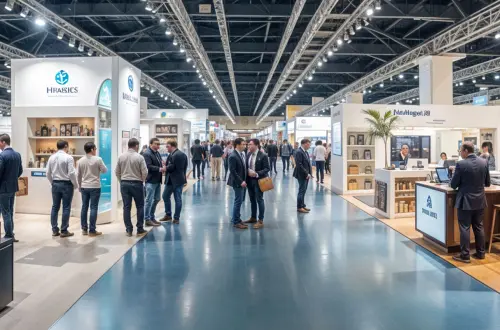Control 2022 – The successful high-quality restart of the QA sector!
The 34th edition of Control marked the successful restart of the leading QA trade fair. The edition took place at Messe Stuttgart amidst absent Covid-19 safety measures. All participants welcomed the change and what it signified. Control 2022 was held between 03.05.2022 and 06.05.2022. The event took place after a two-year extended hiatus and featured 18,531 visitors. It also received 617 exhibitors, with 31% being from foreign nations. The total event space for the event was approximately 23,000 m2.
Control 2022 was held at Messe Stuttgart between 03.05.2022 and 06.05.2022. The event occurred amidst the absence of Covid-19 safety measures. This was due to Germany removing its domestic pandemic-related regulations in April 2022. Yet, the venue installed a series of precautions to reduce the risks of infections. All areas underwent frequent and thorough cleaning sessions. All event spaces included disinfection dispensers, with attendees encouraged to conduct regular disinfection. Among the locations with such dispensers were the entrances and exhibition halls. Participants were also recommended to wear surgical masks in indoor spaces. They were similarly advised to maintain a social distance of 1.5 metres. They also had to adhere to the general hygiene rules. This included following the coughing/sneezing etiquette. The absence of a strict Covid-19 safety plan was quite welcome by participants.
Control 2022 featured several highlights. The distinguishing features of the trade fair were:
- Fraunhofer IPA Event Forum
- Exhibitor Forum
- Fraunhofer Business division Vision
- Machine Vision Forum
The Fraunhofer IPA Event Forum was one highlight of the event. The Event Forum was held in hall 8. It featured a comprehensive lecture schedule that discussed various topics. Eminent subjects included QA trends, manufacturing developments, legislation, and training standards. It also allowed attendees to learn how to identify and examine AI applications. The central session was Trends in Quality Assurance - Digitisation, Automation, and AI in Practice. It featured Andreas Frommknecht as the speaker. The schedule also included prominent sessions, such as:
|
|
Digital QM in transition–from static model to dynamic process execution
The Exhibitor Forum was likewise among the highlights of Control 2022. Like the Event Forum, it was held in Hall 8 at booth 8314. It was once again the communication platform that aided visitors. This included providing in-depth information about the exhibiting companies. This allowed visitors to improve their decision-making and to learn about their innovations. Visitors could also learn about the new research experiences created by science institutes.
The special show Contactless Measuring Technology similarly served as an event highlight. It was held with the aid of the leading company Fraunhofer Business division Vision. The show took place on 300 m2 of event space within Hall 6. It presented various innovative non-contact measuring technologies, applications, and system components. It also provided visitors with guidance related to selecting suitable technology. This allows attendees to examine innovations and network with other participants. The special show featured the new technologies of 17 exhibitors:
|
|
The scanner provides 3D high-resolution scans of large parts. These are then compared to a CAD model. This allows the device to determine the product’s manufacturing quality. ZScan features a modular concept that enables direct integration into various manufacturing processes. As a result, it is suitable for the automotive and e-mobility industry. It is also ideal for processing machines that operate with wood and food. Application examples include measuring aluminium, die castings, bent or stamped parts. They also feature electric car battery busbars and cut good shadow-free volume determination.
- ImageIR® 8300 hp
The thermal imaging camera series aids in analysing extreme temperature gradient objects. This is due to the novel HDR (High Dynamic Range) function. It comprises a rapid rotating filter wheel that promotes continuous measurement recording. The available temperature range is up to 1500 Kelvin. As a result, the series enables full-frame recordings. These consist of images with 640×512 pixels and a temporal resolution of 350 Hz. The innovation applies to metal thermal stress analysis and capillary gap soldering.
- OptoInspect3D Inline
OptoInspect3D Inline can be used independently of digitising services. Such include such as laser scans, light sections and fringe projections. It enables the expeditious and automatic comparison of large amounts of 3D data to create optimal geometries. As a result, each test specimen inspection is possible »inline«. This means that the procedure can occur within the production process. As a result, the series applies to various industries and 3D software providers. It is also suitable for manufacturers of 3D measuring devices. This is due to it allowing them to integrate individual functions into products. The library is also suited for supporting intelligent sensor applications. This is due to its usability with platforms such as Windows and Linux with ARM or Intel CPUs.
- xposure:photometry
Photometry is an innovative system that provides express 3D and 2D inline surface inspections. The system uses an xposure line high-speed scan camera. This is combined with the xposure: flash illumination technology. As a result, users can detect the slightest 3D defects at high speed when inspecting objects. This applies to all types of inspectable items. Such include ones with challenging surfaces, such as metallic, reflective, dark, or grainy. The principle of operation is that of photometric stereo imagining. This enables the innovation to be suitable for use in industrial QC tasks. The examples include examining battery foils, packaging embossing, banknote gravure prints, or infrastructures.
- ZEISS O-DETECT
O-DETECT is an innovative measuring machine for optical 2D contactless measuring. It ensures the accurate measurement of workpiece metric parameters during rigorous inspections. Among them are distance, angles, lengths, and bore diameters. ZEISS O-DETECT is suitable for compact and easy-to-deform components. It is also ideal for workpieces with sensitive and non-tactile-measurable surfaces. This includes the ones created from ceramics, metals, or plastic. The areas of application include the medical sector and the watch industry.
- ZEISS METROTOM 6 scout
METROTOM is a novel industrial CT that digitalises complex components, including internal structures. This is done in a contactless and non-destructive manner. This ensures the high visibility of the fine details. Additionally, it features a 3K X-ray detector with a 3008×2512 pixel resolution. This allows the system to examine components, including small plastic parts. The measurement of each test specimen occurs in the best position possible. This is achieved via automatic 5-axis kinematic object positioning. This ensures the creation of a full 3D image using the highest possible resolution. Such images can be invaluable in form/position analyses or actual comparisons. Users can also use the results to create reliable statements about component quality.
- imanto® obsidian
This is an innovative measurement system for thin film and hyperspectral surface testing. The sample is inspected using light reflected from the test area. The light is then analysed using hyperspectral imagining or HSI. Recording the data using spatial and spectral resolutions is part of the analysis. HSI works on the principle of the spectral change of optical behaviour. According to the precept, topology- and material-related surface conditions manifest a spectral shift. The change occurs by altering the optic behaviour of the light. This takes place via deviating absorption, refraction, or scattering. This enables HSI to act as a universal tool for visualising and determining layer and surface parameter distribution. Also, this applies to the sample properties derived from such aspects. As a result, users can clarify industry processes to improve their effectiveness.
- Consigno
»Consigno« is an innovative 3D surface measuring system that can serve many purposes. This includes a laboratory measuring device and an OEM measuring head. This allows users to automate metrology tasks of various types without encumbering. The innovation uses the confocal measuring principle. It incorporates the depth-of-field range for topographic detection. The postulate is used for surface inspections, such as the functional ones found on micro-optics. The device can also determine the geometric properties of injection-moulded plastic components. One such property is gradation height. Furthermore, the system allows for determining the roughness of various component surfaces. It can also measure contours.
- Helios2+3D time-of-flight camera
It features an augmented variant of the Helios2 system as two new processing modes — HDR and HSM. HDR or High Dynamic Range provides precise and accurate depth information. This also applies to high-contrast, complex scenes with high/weak reflective objects. This is due to the mode merging images within the phase domain. The HSM mode detects the depth of the examined area using a single measurement. This ensures the accurate 3D distortion-free imaging of moving objects. The results are achieved using quick acquisition speed and high frame rates. The modes allow users to use the device in various challenging work environments.
The Machine Vision Forum was one of Control 2022’s highly distinguished features. It presented the latest quality assurance and control-related knowledge in a practice-oriented format. The Forum enables attendees to learn about the means to solve tasks related to Industry 4.0. Such include digitalisation of manufacturing or assembly and incorporating of image processing. The Forum was available on all four event days. It was held with the aid of evotron academy. The Machine Vision Forum took place in Hall 8 and was held in German. The sessions of note included:
- Introducing machine vision - improve product quality and processes and save costs
- Digital light–the ideal basis for expeditious and reliable image processing
- Professional implementation of machine vision projects
The speakers also could host one-on-one meetings with participants to answer topic-related questions.
Control 2022 marked the successful restart of the lead trade fair for QA solutions. Exhibitors stated they experienced immense joy at being able to attend. Visitors likewise expressed high excitement at the in-person attendance opportunity. Among the stated causes were the opportunities to engage in face-to-face exchanges. They also included being able to experience innovations with all senses. Control 2022 received 18,531 expert visitors and 617 exhibitors. The hosting space for the event was approximately 23,000 m2. 31% of the exhibitors represented foreign countries such as Switzerland, Italy, the USA, and the UK.


